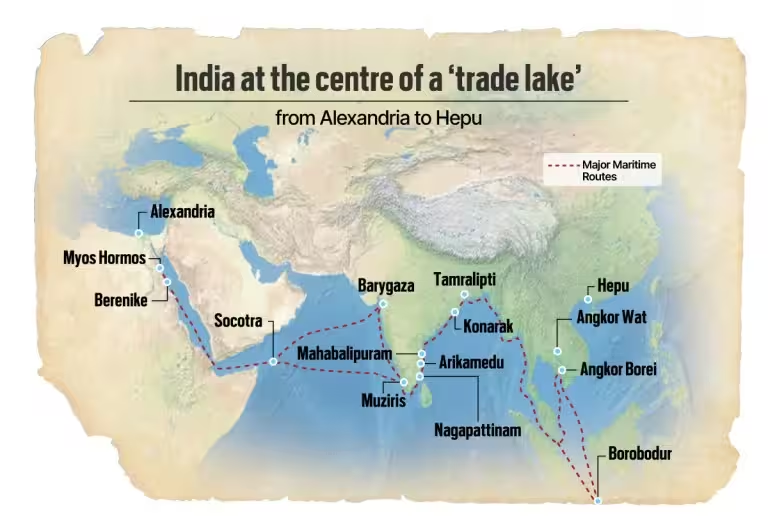Important Facts For Prelims
INSV Kaundinya
- 23 May 2025
- 4 min read
Why in News?
The Indian Navy recently inducted the Indian Naval Sailing Vessel (INSV) Kaundinya, the 1st ‘stitched ship’ using ancient stitched shipbuilding method (Tankai method) to revive forgotten shipbuilding techniques.
- It is named after Kaundinya, a legendary Indian mariner, and set to embark on a historic voyage to Oman by the end of 2025, retracing ancient trade routes.
- It is executed through a tripartite agreement between the Indian Navy, Ministry of Culture, and a Goa-based shipbuilding company.
What are Key Facts About INSV Kaundinya?
- About INSV Kaundinya: It is a stitched ship modeled after a vessel depicted in the 5th-century Ajanta cave paintings.
- It is inspired by Ajanta murals, the ancient text Yuktikalpataru (written by King Bhoja in 9th century CE), and accounts of foreign travellers who described stitched Indian ships.
- It features symbolic motifs like:
- Gandabherunda, two-headed eagle of the Kadamba dynasty who ruled the Konkan coast
- Sun motifs on sails
- Simha Yali (mythical lion) on the bow
- Harappan-style stone anchor.
- About Kaundinya: Kaundinya was a 1st-century Indian mariner, known for sailing to the Mekong Delta, where he married warrior queen Soma and co-founded the Kingdom of Funan (modern-day Cambodia), one of the earliest Indianised states in Southeast Asia.
- The Khmer and Cham dynasties of modern-day Cambodia and Vietnam trace their origins to this union.
- His story is preserved in Cambodian and Vietnamese sources, though not in Indian records, and he is regarded as the first named Indian mariner to make overseas voyages with global historical impact.
- Tankai Method: It is a 2,000-year-old traditional Indian shipbuilding technique known for its manual craftsmanship, indigenous materials, and non-industrial techniques. Key Features include:
- Stitched Plank Technique: Teak, sal, or mango wood planks are drilled and stitched with coir ropes, then sealed with cotton, resin, and fish oil for waterproofing.
- No Metal Fasteners: Unlike European methods using iron nails, the Tankai method avoided metal to prevent rust, making ships lighter, more flexible, and easier to repair.
- Unique Construction: The hull is built first, then added ribs, allowing greater flexibility and durability in rough seas, unlike Western frame-first methods.
- Indigenous Materials: Uses coir rope, dammar resin, and animal fat, all resistant to seawater.
UPSC Civil Services Examination Previous Year Question (PYQ)
Prelims
Q. Belt and Road Initiative is sometimes mentioned in the news in the context of the affairs of (2016)
(a) African Union
(b) Brazil
(c) European Union
(d) China
Ans: (d)







